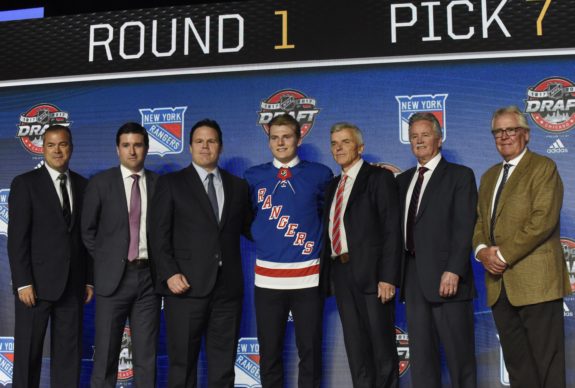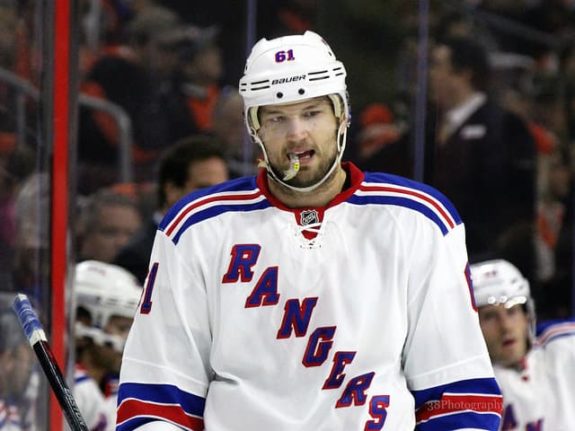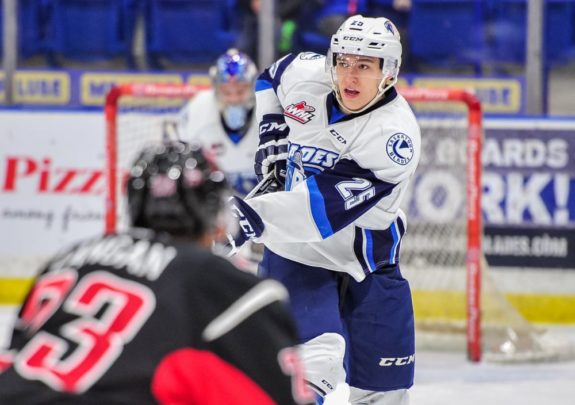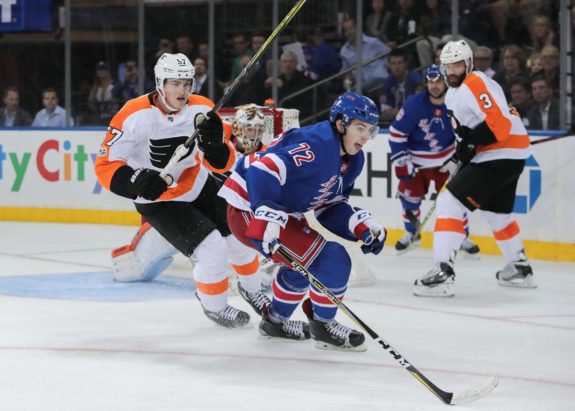Times are exciting around the New York Rangers these days.
Youthful enthusiasm, brought forth by the multitude of kids getting a chance to prove themselves, and a total absence of pressure to make the playoffs, has contributed to the light mood surrounding an organization that’s looking to the future and appears well-positioned to build a bright one — maybe quicker that expected.
Amid the considerable optimism, though, it’s worth pointing out that the Rangers need to differentiate this next build toward contention from the last one, which nonetheless yielded a terrific core that made three Eastern Conference finals appearances and one trip to the Stanley Cup Final. Specifically, the critical elements that those Blueshirts lacked and left them short of lifting the Stanley Cup need to be procured this time around.
Assets are assets, and the Rangers have plenty of them in the form of draft picks and youngsters acquired through their deadline trades and last season’s draft. The question remains whether all of that will yield another very good team that consistently contends yet falls short of the ultimate goal, or if they deliver the key pieces needed to finally bring home the Cup.

So while one or more of these important players might come via free agency, it seems more likely that the Rangers will need to find at least a couple of them using their haul of futures, be it through draft picks or trades, as they try to build a champion in the coming years.
So, in no particular order…
A Game-Breaking Forward
The absence of such a player is apparent in the contrast between the Rangers coming close to the Cup three times and teams like Chicago and Pittsburgh winning multiple championships when advancing deep into the playoffs. Since the salary cap came into existence, only the Penguins (157) have played more playoff games than the Rangers, with 129. Chicago has played 128.
Yet the Blackhawks have won three championships since 2010 in large part because they have Patrick Kane and Jonathan Toews, and the Penguins, seeking a three-peat this season, possess Sidney Crosby and Evgeni Malkin. To be sure, both of those clubs also had deep rosters built through strong personnel development and shrewd trades, but superstars generally make the difference in the NHL playoffs — or any other sport’s postseason, for that matter.
Rick Nash and Martin St. Louis were admirable, logical additions by Glen Sather, whose bold trades for those players acknowledged his team’s shortcoming in that area. Neither ultra-talented winger proved to be enough to put the Rangers over the top, and in Nash’s case, his failure to deliver in the tournament was often stark.

Access to the elite talent near the top of the draft has eluded the Rangers for most of this century, the club of a victim of the success that’s resulted in it making the playoffs in 11 of the 12 seasons of the cap era before this one. Even being at the very top of the draft hardly guarantees a generational player (see: Edmonton Oilers pre-Connor McDavid), but the Blueshirts have little choice but to resume the elusive search for the superstars they’ll so desperately need.
Henrik Lundqvist handled that role solo during the recent runs at a championship, but the notion that he’ll still be around and still at or near the top of his game when the Rangers are ready to contend for the Cup again is likely wishful thinking. Not having The King to bail them out at the back end means more of the load will have to be carried up front.
The solid post-trade deadline results aren’t helping, of course, with the Rangers’ chances to secure a top-three draft pick diminishing with each point earned during their 5-3-2 stretch — even if no less an authority than Lundqvist thinks it’s good for the future. A big-time scorer can be found lower in the first round, of course, but history shows that such a player is much more likely to come from the top five.
The presumptive top pick this year isn’t a forward anyway, as Rasmus Dahlen is viewed as a future No. 1 defenseman that’s close to being ready to play in the NHL almost immediately. Getting a shot at him would be OK for the Rangers, though, as this would address another key need.
An Elite Defensive Pair
Brian Leetch seems so long ago now. Ryan McDonagh looked to be on his way to inheriting No. 2’s mantle, but as good as Mac is, he proved not to be Leetch. He and Dan Girardi weren’t a shutdown defensive pair, a fact brutally exposed in the 2014 Cup Final against Los Angeles. The closest thing those Rangers had to a lockdown defenseman on that team turned out to be the unheralded Anton Stralman, who left for Tampa Bay after that season and proceeded to pair with Victor Hedman to form one of the top blue line tandems in the league.
The Rangers need to find their Leetch-Jeff Beukeboom for this generation. The good news here is that one of those players might already be in the organization: Libor Hajek, acquired from the Lightning in the McDonagh-J.T. Miller trade, is seen by some scouts as having the best chance among that group to develop into a top defenseman. If he’s part of a future No. 1 pairing, the Rangers will have done well in that deal, though they’d certainly like more from what they received from Tampa Bay.

Whether it’s Hajek as a starting point or good fortune smiling on the organization in the form of a chance to draft Dahlen or another top defensive prospect, a dominant top blue-line pairing is on the Blueshirts’ wish list. The shot bombardment Lundqvist and other Rangers goalies have faced this season makes that pretty clear. It’s worth remembering that future Hall of Famer Duncan Keith was chosen 54th overall by the Blackhawks in 2002, so Jeff Gorton and Co. needn’t hang their heads if they don’t win the draft lottery and Dahlen proves not to be in the cards.
And, finally.
A Top Centerman
This was another shortcoming that was glaring during the Cup Final against the Kings, who dominated the Rangers down the middle with big and talented centers Anze Kopitar, Jeff Carter, Mike Richards and Jarret Stoll. Brad Richards, Derek Stepan, Derick Brassard and Brian Boyle simply couldn’t match up, and the problem has never been remedied.
Stepan assumed the No. 1 role following Brad Richards’ departure via the amnesty provision after that season, but he was at best a “1A” centerman, and really better suited to be a No. 2. The Rangers have certainly missed his contributions this season, but the decision to trade him last offseason reflected in part the fact that he isn’t that rare commodity of a No. 1.
The trouble is that no one else has approximated such a player for the Blueshirts since Mark Messier, with a series of good-but-not-great players manning the middle for a contending team that sorely needed a center that could score, win faceoffs, make others around him better and win match-ups with other No. 1s.
The question again is, do the Rangers already have that asset in the organization, or a reasonable belief that they’ll have a shot at such a player through the draft, perhaps using one of their three first-round picks in June to discover one?
The Rangers have high hopes for Lias Andersson and Filip Chytil, first-rounders in 2017 who are expected to play the majority of the remaining 10 games as the club gets a free look without burning off the first year of their entry level contracts. The same can be said for Brett Howden, acquired in the McDonagh deal. Does one of those three develop into a legitimate No. 1 pivot on Broadway?

The Rangers’ success of 2011 to 2017 was based largely on excellent depth in front of an all-world goalie. That formula was very good, but not good enough to win the Stanley Cup, and the absence of each of these three crucial elements can be pinpointed as major reasons for that. The organization has a lot to work with, and reasonably good opportunity, as it looks to finally fill those holes.
Unfortunately, the question of whether the Rangers accomplish that probably won’t be answered for a while.